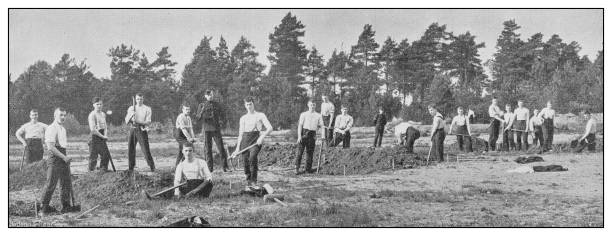

“The most important, and indeed the truly unique, contribution of management in the 20th century was the 50-fold increase in the productivity of the manual worker in manufacturing.”
— Peter Drucker, Management Challenges for the 21st Century
The most respected management thinker in history isn’t just talking about fiftyfold productivity for the smartest people. He’s talking about fiftyfold productivity on average for 100 million-plus people.
To put this in context, imagine if you could get an entire weeks’ work done in less than an hour? Or if you could work a full work week, but got 50x the results of everyone else?
But, oddly, after this huge societal boost in productivity, something very strange happened.
At the exact point where you’d think there would be another boost in productivity due to the introduction of the internet, there was stagnation. The evolution of the web should have led to dramatic improvements in productivity, yet they are invisible in the data. This is known as the productivity paradox.
This paradox led Drucker to issue a challenge for our generation:
“The most important contribution management needs to make in the 21st century is similarly to increase the productivity of knowledge workers.”
Over the last 9 years in my rapidly growing recruiting software company, I’ve taken on Drucker’s Challenge and succeeded. We’ve gone from zero to tens of millions of dollars in revenue with 13,200+ customers. More so, we’ve achieved this through a very methodical process.
What I learned boils down to two sentences: At first, gaining a 50x productivity boost sounds impossible. But, if you have the right process and use the 50X playbook, it’s realistic for almost any knowledge worker.
In this article, I will share two things with you:
By the end of the article, you’ll have what you need to take the 50x Challenge yourself.
In 2010, I was a 29-year-old vice president of operations at a high-growth SaaS software company. It was high time to found my own startup. The core theme that consumed my thoughts was that artificial intelligence (AI) would revolutionize every industry in the decades to come. The notion that you could develop software that would learn on its own and improve performance for the people who relied on that software to perform their job inspired me. That was the future. I wanted to go create it.
For 24 months leading up to launching my company, I spent two hours per day after work and on weekends minimum:
In other words, rather than winging it, I spent the equivalent of nearly a year of full-time work turning over every pebble (not stone) in order to find and validate the business idea that I could go all-in on. I was looking for a huge market opportunity that would combine artificial intelligence and software and had the potential to change the world in some small way.
After this long discovery process, I finally settled on the recruiting industry for two reasons:
Now that I had the vision and business model, I spent the next 18 months methodically integrating Stanford Professor Steve Blank’s lean startup methodology and launchpad. A key part of this process involved meeting with and learning from hundreds of recruiters. Simultaneously, I actually started recruiting on my own. This allowed me to intimately understand how things worked from a first-principles perspective.
In 2013, after more than 18 months in the discovery phase, I brought together the initial team and we finally began building the first prototype of a software that reinvented the entire recruiting workflow rather than simply improving the existing one. I called the software Loxo.
Since then, I’ve conducted 5,200+ discovery sales conversations with recruiting organizations of all types and sizes. Our Loxo software has continually improved to the point where market demand is pulling us faster than we can keep up. We will exceed 150 employees in the next year, have 13,200+ clients across the globe, and recently expanded into Europe with our first international office.
More importantly, the result has been a fiftyfold boost in productivity for the average recruiter using our software.
Now that you understand my general process, it’s important to understand the historical precedent that caused the 50x productivity boost. By understanding my approach and the historical approach, hopefully, you’ll see an underlying process you can use in your own business.
What we’ve been taught about productivity is wrong. Technology is NOT the fundamental cause of productivity. Mastering the latest and greatest tools will not take you to the promised land of productivity.
What I learned and what history shows us is that what really matters is workflow optimization. In other words, it’s about perfecting the step-by-step workflow first, then harnessing technology to turbocharge.
Technology with a bad process is similar to pushing a boulder up a hill. Technology with a great process can result in a 50x productivity boost.
This brings me to Frederick Winslow Taylor, one of the world’s first management consultants and author of Principles Of Scientific Management.
The core thesis of the book boils down to one sentence:
Replace work by the rule of thumb, habit, and common sense with the scientific method in order to boost productivity.
Later in the book, Taylor explains why this is important…
This diverse body of practice based on the “rule of thumb” is far from optimal. You might think that if a profession has been around for decades and even centuries that it would discover the optimal processes and pass those down. However, Taylor’s work showed that this doesn’t happen.
Taylor describes what it means to apply the scientific method to work with these three steps:
Using this system, Taylor achieved astounding results for tasks you would think are impossible to improve. Let’s take something as simple as shoveling as an example.
First, Taylor questioned basic assumptions:
For a first-class shoveler, there is a given shovel load at which he will do his biggest day’s work. What is this shovel load? Will a first-class man do more work per day with a shovel load of 5 pounds, 10 pounds, 15 pounds, 20, 25, 30, or 40 pounds?

Sandhurst
Next, Taylor answers these questions via experimentation. He varies the shovel load and has managers trained in the scientific method document the results. After several weeks of experimentation, he found the optimal shovel load was 21 pounds.
The example above is not just hypothetical. Taylor helped create a science of shoveling at Bethlehem Steel Company for its 600 shovelers. That science included thousands of stop-watch observations and experiments on:
What was the end result of these shoveling experiments?
Within three years, the output per man doubled. As a result, employees earned 35% more on average while the company paid significantly less.
All of this from turning the simple act of shoveling into a science.
Taylor gives other fascinating case studies in the book. One amazing example is bricklaying. This trade has literally existed for 10,000 years. There had been almost little for hundreds of years. Yet, one company was able to improve efficiency by 3x. Using the principles of scientific management, they…
Taylor was not alone in using scientific management principles. Henry Ford used the same principles to invent the assembly line realizing that much of a worker’s time was wasted simply walking between materials and tools.
The following quote from Ford captures the implication, “He gets small pay because pedestrianism is not a highly paid line.”
So, Ford, had the work come to workers rather than them walking to the work. This innovation was called an assembly line. Second, Ford noticed that a lot of time was spent stooping over to pick up materials from the ground and putting them on the assembly line, so he made multiple assembly line heights based on worker height.
The most fascinating part of Ford and Taylor’s insights is that easy-to-understand, simple-to-implement changes in the process could have dramatic improvements, yet went undiscovered by others. It conjures up the surprising detail that a suitcase with wheels wasn’t invented until the 1980s.
The need for scientific management rings true just as much as 100 years later.
One hundred years later, most knowledge work is still done via the rule of thumb, habit, and common sense. Most of a knowledge worker’s time is spent doing things other than those activities that yield the highest business impact.
Today, knowledge workers spend an average of 41% of their time on unimportant discretionary tasks and 55% of their time on managing across, up, or down within the organization.
In my story, in Taylor’s work, and with Ford’s insights, we see the same lessons again and again:
Now that you see that there is a proven and doable process to get a 50x productivity boost for you specifically and your company more broadly, it’s time to ask yourself a fundamental question…
Imagine the business impact and competitive advantage if knowledge workers were given a software platform integrated with a playbook designed for that specific industry. The end goal should always be to have workers spend the majority of their time on the highest value tasks.
When you use this logic, align incentives, and then add in artificial intelligence, a 50x productivity boost no longer seems crazy. In fact, it feels the opposite. It feels inevitable.
The original article was first published on Forbes.com available to view here.
Special thanks to Michael Simmons for his collaboration in co-developing the ideas in this article. If you want to go deeper into how Michael developed his own article as a result of our collaborations, then visit his page and check out some of publications.